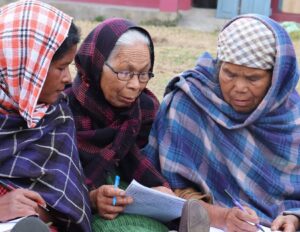Forest Management Practices (FMP) in Meghalaya are unique, strategic and tailored to various purposes and needs. The NESFAS project – “Protection of Forests in Meghalaya by Adopting Participatory, Gender-Centric, and Equitable Approaches,” supported by The Nature Conservancy, has highlighted the effectiveness of these practices. A detailed documentation through the People’s Biodiversity Register (PBR) highlighted valuable information into the forest management practices in various communities of Meghalaya. The examples here are drawn from the Khasi Hills region, showcasing the diverse types of forests managed under different community and private stewardship.
- Khlaw Raid (Community Forest):
Khlaw Raid is a community-managed forest controlled by a village, a group of villages, or an Elaka. Every community member has the right to use the land without paying land revenue, but no individual has proprietary, heritable, or transferable rights over it. If left unutilized for three years, the right to use and occupancy reverts to the community.
2. Khlaw Shnong (Village Forest):
Owned and managed by a particular village, Khlaw Shnong forests are controlled by the Village Dorbar. Villagers can collect resources like timber, firewood, mushrooms, wild fruits, and other non-timber products. Some villages allow cultivation for a limited period (5-10 years) to benefit villagers and raise village funds, after which the forest is left undisturbed for 10-15 years. These forests cannot be used for commercial purposes or Jhum Cultivation without Village Council permission.
Subtypes of Khlaw Shnong:
Kshap: Smaller than Khlaw Shnong and located near cliff edges or areas unsuitable for agriculture. Managed similarly but without individual ownership claims, and cultivation is prohibited. Forest resources can be harvested for community use, such as bamboo cultivation.
Khlaw Sordar: Managed by the Sordar (community head), historically used for shifting cultivation by households without farmland. Rent paid to the Dorbar Shnong contributes to the community fund. For example, Khlaw Sordar in Umsawwar community, Mawkynrew block, has been used for broom grass cultivation in recent decades.
- Khlaw Adong (Restricted Community Forest):
It is similar to Khlaw Shnong but with stricter protection. Timber and firewood extraction are prohibited except for cremation purposes. Non-timber forest products like vegetables and mushrooms can be extracted without harming the forest. Often used as water catchment areas, these forests are managed by the concerned community.
- Khlaw Kur (Clan Forest):
Belonging to a particular clan, Khlaw Kur is Ri Kynti (private land/forest) that hasn’t been divided among clan branches or families. Management and conservation are the responsibility of the clan. Agricultural practices are allowed with the Dorbar Kur (clan council) or Dorbar Kpoh (branch council) permission. Some are sanctified, forbidding timber or firewood collection due to beliefs that cultivation brings bad luck, preserving their rich biodiversity. Examples include Khlaw Kur Rani in Nongwah, Khlaw Kur Khongsit in Kongthong, and Khlaw Kur Diengdoh in Mawthawtieng.
- Khlaw Balang (Church Forest):
Managed by a church, these forests are used for agricultural practices to raise church funds. Typically, forests are left undisturbed for 5-10 years, then made available for multipurpose uses like agriculture or broom cultivation for 3-5 years before being left undisturbed again. Examples include Khlaw Balang of Diengsong and Khlaw Balang Kshaid. In Khrang and Nongbah communities, they are also used as cemeteries.
- Law Rikynti / Law Shimet (Private Forest):
The majority of Meghalaya’s forests fall into this category as they are owned by individuals or families and are heritable. They are managed and used according to the owner’s needs, often focused on productive purposes like agriculture, charcoal burning, or agroforestry (forest gardens).
- Khlaw Ryngkew/Khlaw Lyngdoh (Sacred Groves):
Also known as ‘Law Kyntang’ or ‘Law Niam’, these forests are set aside for religious purposes and managed by the Lyngdoh (religious priest) or a designated person. Belonging to specific clans, the management is left to the clan council. These groves serve as natural habitats for rare flora and fauna, playing a crucial role in biodiversity conservation. Examples include Law Ryngkew in Khatar Shnong, Law Ryngkew Diengdoh in Mawthawtieng (belonging to the Kur Diengdoh), Law Khongsit in Kongthong (belonging to Kur Khongsit), and Khlaw Nongrum in Rikyrshang (belonging to Kur Nongrum).
These forest management practices illustrate Meghalaya’s rich cultural and ecological heritage, where community involvement and traditional knowledge play vital roles in preserving biodiversity and sustaining livelihoods. Each type of forest serves specific community needs, from resource collection to religious practices, highlighting the intricate balance between human use and environmental conservation.



